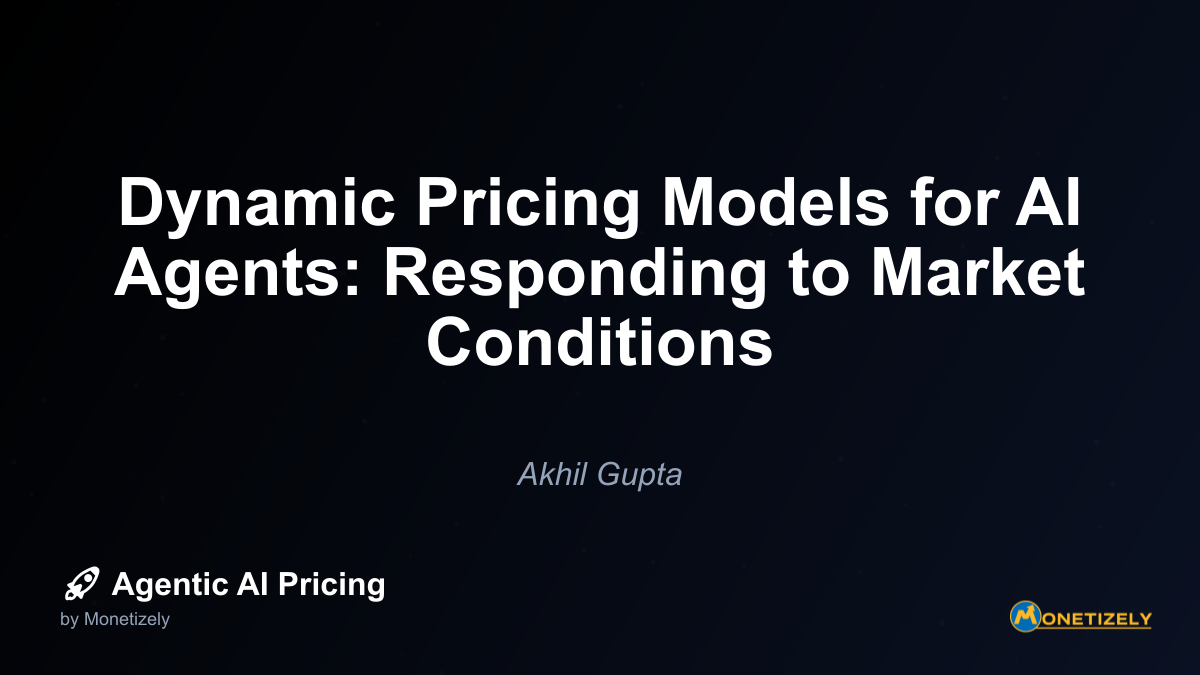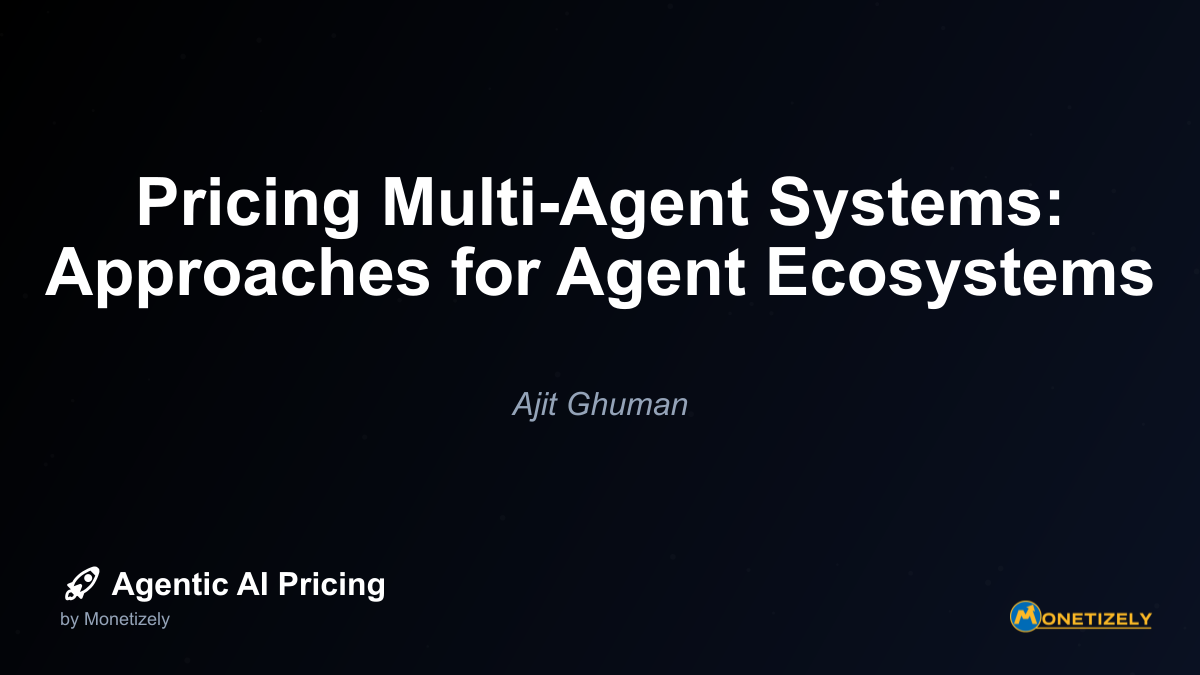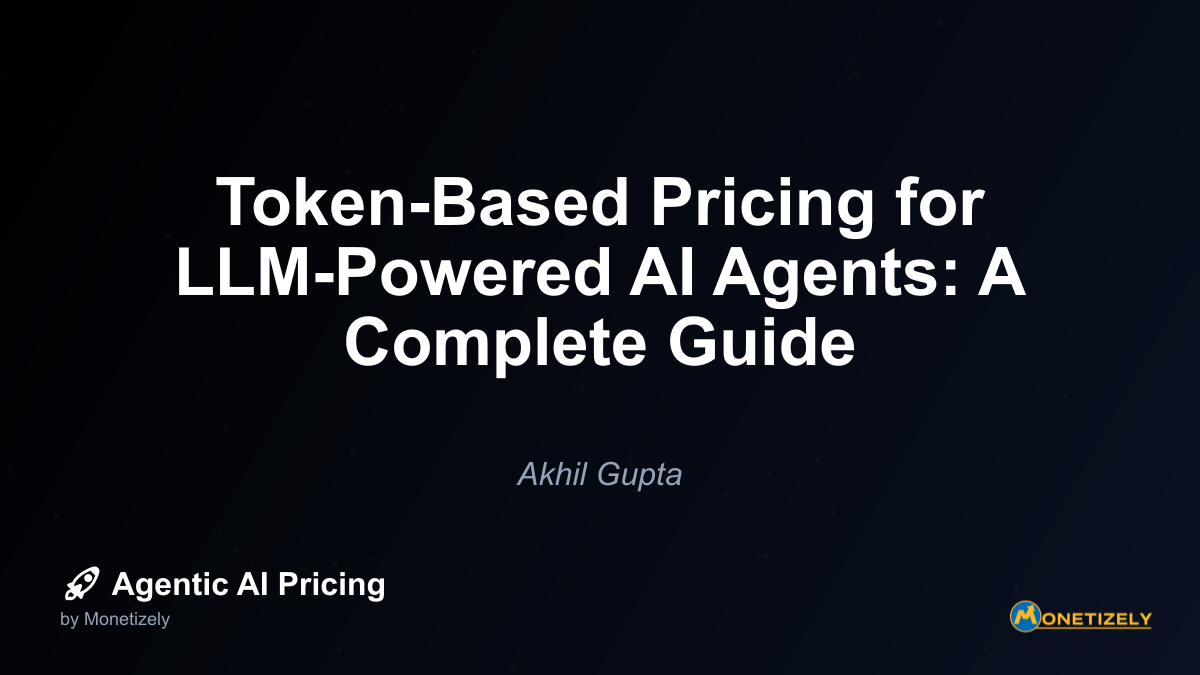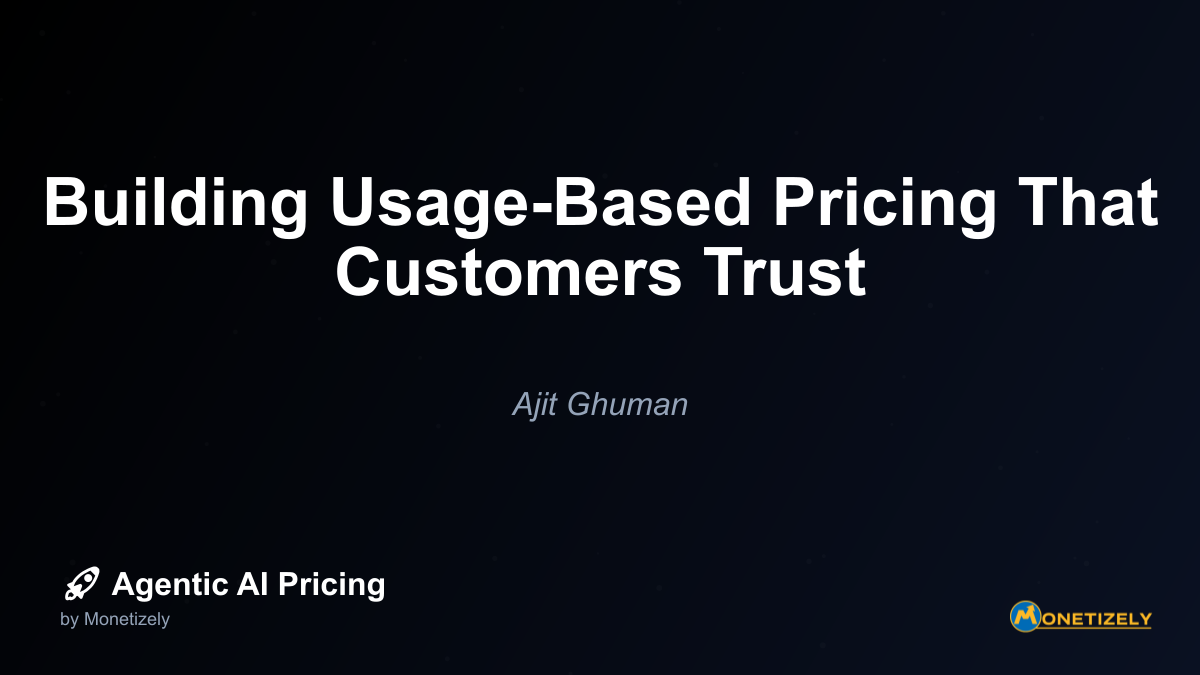· Akhil Gupta · AI Pricing Models · 12 min read
Metered Usage Models: Granular Pricing for AI Capabilities
AI and SaaS Pricing Masterclass
Learn the art of strategic pricing directly from industry experts. Our comprehensive course provides frameworks and methodologies for optimizing your pricing strategy in the evolving AI landscape. Earn a professional certification that can be imported directly to your LinkedIn profile.

In today’s rapidly evolving AI landscape, businesses are increasingly turning to granular pricing approaches to monetize their AI capabilities effectively. Metered usage models have emerged as a sophisticated strategy for aligning costs with value, particularly as AI services grow more complex and resource-intensive. These models move beyond traditional subscription-based approaches to capture the multi-dimensional nature of AI consumption.
The Shift to Granular AI Pricing
The AI market is experiencing a fundamental transformation in how services are priced and consumed. According to recent data, over 53% of SaaS businesses now incorporate some form of usage-based pricing, up from 31% in previous years. This shift reflects the unique economics of AI services, where computing costs can vary dramatically based on usage patterns and resource requirements.
Traditional per-seat licensing models, while simple to understand and implement, fail to capture the variable nature of AI consumption. When customers use an AI service, they might engage with it in countless ways—generating text, analyzing images, processing audio, or performing complex reasoning tasks—each with different resource implications.
The metered usage approach addresses this complexity by charging customers based on their actual consumption of AI resources. This creates a more equitable pricing structure that scales with customer value and aligns provider revenue with actual costs.
Core Dimensions of Metered Usage in AI
Metered usage models for AI services typically incorporate multiple measurement dimensions to accurately reflect resource consumption and value delivery. Understanding these dimensions is crucial for both providers designing pricing models and customers evaluating AI services.
Token-Based Metering
For large language models (LLMs) and text-based AI services, token-based metering has become the industry standard. Tokens represent units of text processing, with one token roughly corresponding to 4 characters or 0.75 words in English.
Leading providers like OpenAI, Anthropic, and Google implement token-based pricing with distinct rates for:
- Input tokens: Text sent to the model for processing
- Output tokens: Text generated by the model in response
This differentiation reflects the asymmetric costs of generating content versus consuming it. Output tokens typically cost 2-3 times more than input tokens because generation requires more computational resources than processing existing text.
According to a 2025 pricing comparison from Agents24x7, OpenAI charges $7 per million input tokens and $21 per million output tokens for GPT-4 Turbo, while Anthropic charges similar rates for their comparable Claude models.
Compute-Based Metering
Beyond tokens, some AI services meter based on the computational resources required:
- GPU/CPU hours: Time spent utilizing specialized hardware
- Memory utilization: Amount of RAM required for large context windows or complex operations
- Batch processing volume: Quantity of operations performed in parallel
Microsoft’s Azure OpenAI service, for example, offers batch API pricing that incentivizes high-throughput workflows, recognizing that batched operations are more efficient than individual calls.
Multi-Modal Dimensions
As AI services expand beyond text to handle images, audio, and video, pricing models have evolved to incorporate these additional modalities:
- Image generation/analysis: Priced per image or by resolution/complexity
- Audio processing: Typically charged per minute of audio
- Video processing: Often billed based on duration and resolution
OpenAI’s DALL-E 3 image generation service charges per image created, with pricing varying based on resolution and quality settings. Their Whisper speech-to-text API charges per minute of audio processed.
Feature-Based Dimensions
Advanced AI services may include additional metering dimensions based on specific features or capabilities:
- Fine-tuning usage: Charges for customizing models on proprietary data
- Retrieval operations: Fees for knowledge retrieval from external sources
- Function calling: Metering based on API integrations or tool usage
Technical Implementation of Metered Usage Systems
Implementing a robust metered usage system for AI services requires sophisticated technical infrastructure. Companies must accurately track consumption, process usage data, and integrate with billing systems—all while maintaining performance and reliability.
Event-Driven Architecture for Usage Tracking
Modern metered billing systems for AI typically employ event-driven architectures to capture usage data in real-time. A case study from Cloudraft demonstrates this approach:
- An Event Listener Service tracks token usage and other metrics in real-time
- Events are published to a message broker (e.g., NATS) for asynchronous, scalable communication
- A Metering Service consumes these events and sends usage data to a billing platform
This architecture enables accurate tracking without creating performance bottlenecks in the AI service itself. The message broker ensures that even during high-volume periods, usage events are reliably captured and processed.
Data Pipeline Components
A comprehensive metering system for AI services typically includes:
- Event collection services that capture usage metrics at the point of consumption
- Message brokers (Kafka, AWS Kinesis, NATS) for reliable event streaming
- Time-series databases (InfluxDB, TimescaleDB) or NoSQL stores for usage data
- Aggregation services that calculate billable units from raw usage data
- Visualization tools for customer dashboards and internal analytics
Yellow.ai, a conversational AI company valued at over $500 million, implemented this type of architecture using Togai’s quote-to-cash marketplace. Their system integrated with their existing Zuora billing platform, enabling support for advanced features like prepaid billing and credit functionality at the product level.
Integration with Billing and CRM Systems
Usage data must flow seamlessly into billing platforms that can support complex pricing models. This integration typically involves:
- APIs or middleware that transmit usage data from AI services to billing systems
- Automatic association of consumption data with customer accounts
- Generation of invoices based on usage and pricing rules
- Synchronization with CRM systems for holistic customer management
Chargebee developed a flexible, no-code usage metering engine specifically designed for AI products. Their system allows companies to define custom metered features from raw event logs, supporting complex aggregation methods like SUM, COUNT, and SQL queries. This approach enables rapid experimentation with pricing models without requiring engineering resources for each iteration.
Industry Adoption and Case Studies
Major AI providers have embraced multi-dimensional metered usage pricing, though with varying approaches reflecting their market positioning and technical capabilities.
OpenAI’s Multi-Dimensional Approach
OpenAI implements a comprehensive multi-dimensional pricing model across their product suite:
- GPT-4 Turbo: Separate rates for input tokens ($7 per million) and output tokens ($21 per million)
- DALL-E 3: Per-image pricing with resolution-based tiers
- Whisper: Per-minute pricing for audio transcription
- Fine-tuning: Additional charges for model customization
OpenAI communicates these pricing dimensions through detailed documentation and transparent tier breakdowns. Their approach balances complexity with clarity, offering specialized pricing for different AI modalities while maintaining a coherent overall structure.
Anthropic’s Simplified Token-Based Model
Anthropic has opted for a more focused approach, emphasizing predictability over breadth:
- Claude models (Haiku, Sonnet, and Opus): Priced solely on input and output tokens
- Simplified tiers: Clear differentiation between model capabilities
By avoiding complex multi-modal pricing, Anthropic positions itself as a cost-stable solution, particularly attractive to small and medium enterprises seeking predictable AI expenses.
Microsoft Azure’s Enterprise Integration
Microsoft’s Azure OpenAI Service extends the token-based approach with enterprise-focused features:
- Regional pricing: Different rates based on data residency requirements
- Batch API discounts: Incentives for high-throughput workflows
- Integration benefits: Pricing advantages when combined with other Azure services
Microsoft emphasizes the integration benefits within their broader cloud ecosystem, appealing to enterprises with existing Azure investments.
Google’s Efficiency Focus
Google’s approach with their Gemini models incorporates efficiency considerations:
- Standard token pricing: Separate rates for input and output tokens
- Specialized model variants: Different pricing for models optimized for specific tasks
- Efficiency-based experiments: Early exploration of outcome-based pricing models
Google and other providers are increasingly experimenting with efficiency-based pricing, focusing not just on raw token consumption but on the results or outcomes achieved.
Challenges and Limitations of Current Metered Usage Models
While metered usage pricing offers significant advantages for AI services, it also presents challenges that providers and customers must navigate.
Cost Predictability Issues
One of the most significant challenges with metered usage models is cost predictability. Unlike fixed subscriptions, usage-based billing can result in unexpected expenses if consumption spikes. According to a 2025 study by Zylo, 66.5% of IT leaders reported budget-impacting overages with consumption-based AI pricing.
To address this challenge, companies are implementing:
- Usage dashboards with real-time consumption tracking
- Budget alerts that notify customers when approaching thresholds
- Spending caps that limit usage to predefined budgets
- Usage simulators that help estimate costs before full implementation
Chargebee’s platform, for example, includes live dashboards showing usage versus purchased limits, helping customers monitor and control their spending.
Complexity in Usage Tracking
Accurately tracking AI usage across multiple dimensions presents technical challenges, especially for complex AI systems with multiple components and integration points. According to CloudZero’s 2025 State of AI Costs report, only 23% of enterprises can predict their AI spending on a monthly basis, underscoring the complexity of usage tracking.
Companies are addressing this through:
- Unified metering platforms that consolidate usage data across services
- Standardized event schemas for consistent tracking
- Automated reconciliation processes to ensure accuracy
- Audit trails for transparency and dispute resolution
Energy Costs and Environmental Impact
AI workloads can consume substantial data center power—potentially reaching 3-4% of global electricity by 2026. This raises concerns about the environmental impact of AI usage and the need to incorporate sustainability considerations into pricing models.
Forward-thinking companies are beginning to address this by:
- Factoring energy costs into pricing models
- Offering green AI initiatives with renewable energy options
- Providing efficiency metrics alongside usage data
- Implementing carbon-aware scheduling for non-time-sensitive workloads
Strategic Pricing Considerations for AI Providers
Implementing an effective metered usage model requires careful strategic consideration beyond the technical implementation details.
Aligning Metrics with Customer Value
The most successful metered pricing models align closely with the value customers receive. This requires identifying metrics that correlate with customer outcomes rather than just technical resource consumption.
For example, a customer service AI might be priced based on:
- Number of successfully resolved tickets
- Customer satisfaction scores for AI-handled interactions
- Time saved compared to human agents
This value-based approach is more complex to implement but creates stronger alignment between provider revenue and customer success.
Tiered Pricing Structures
Most effective metered pricing models incorporate tiered structures that balance simplicity with flexibility:
- Volume discounts that reduce per-unit costs at higher usage levels
- Feature-based tiers that unlock additional capabilities at higher pricing levels
- Commitment tiers that offer lower rates in exchange for usage commitments
According to Valueships’ 2025 AI Pricing Trends report, 41% of AI companies now use hybrid models combining subscription fees with usage-based components, up from 27% previously.
Transparent Communication
Given the complexity of multi-dimensional pricing, transparent communication is essential. This includes:
- Clear documentation of all pricing dimensions and calculation methods
- Usage dashboards that visualize consumption patterns
- Cost estimation tools that help customers forecast expenses
- Regular usage reports that break down consumption by dimension
Future Evolution of Metered Usage Models
Metered usage pricing for AI is still evolving, with several emerging trends likely to shape its future development.
Integration of Outcome-Based Metrics
The next evolution in AI pricing may combine usage-based metering with outcome-based metrics that directly measure business impact. This could include:
- Revenue attribution linking AI usage to business outcomes
- Efficiency gains measured through time or resource savings
- Quality improvements in outputs or decision-making
This approach would further align provider incentives with customer success, though it requires sophisticated tracking and attribution mechanisms.
Dynamic Pricing Based on Resource Availability
As AI compute resources remain constrained relative to growing demand, we may see more dynamic pricing models that reflect resource availability:
- Time-based pricing with lower rates during off-peak hours
- Priority-based pricing where urgent tasks command premium rates
- Resource-efficiency incentives that reward optimized prompts or batched operations
These approaches could help distribute demand more evenly and encourage more efficient resource utilization.
Regulatory Considerations
Future metered pricing models will need to account for evolving regulatory frameworks around AI, including:
- Carbon accounting requirements that may mandate disclosure of AI’s environmental impact
- Data privacy regulations affecting how usage data can be collected and processed
- Transparency mandates requiring clear disclosure of pricing mechanisms
- Fairness considerations in how different customers are charged
Companies that proactively address these regulatory considerations will be better positioned as the regulatory landscape evolves.
Implementation Roadmap for AI Providers
For AI providers looking to implement or refine their metered usage pricing model, a structured approach can maximize success while minimizing disruption.
Phase 1: Metric Definition and Instrumentation
The foundation of any metered usage model is properly defining and instrumenting the relevant metrics:
- Identify key consumption dimensions that drive costs and reflect value
- Instrument services to accurately capture usage data
- Validate measurement accuracy through testing and auditing
- Establish baseline usage patterns for existing customers
This phase typically takes 2-3 months and requires close collaboration between product, engineering, and finance teams.
Phase 2: Pricing Model Design
With reliable usage data in hand, the next step is designing the pricing model:
- Analyze cost structures to understand the economics of different usage patterns
- Model various pricing scenarios and their impact on different customer segments
- Design tiered structures that balance simplicity with flexibility
- Develop clear communication materials explaining the pricing approach
This phase typically takes 1-2 months and should involve marketing, sales, and customer success teams alongside finance.
Phase 3: Pilot Implementation
Before full rollout, testing the model with a subset of customers is crucial:
- Select representative pilot customers across different segments
- Implement shadow billing to compare new and existing pricing approaches
- Gather feedback on pricing structure and communication clarity
- Refine the model based on real-world usage and feedback
According to implementation data from Monetizely, pilot phases typically last 2-3 months and involve 5-10% of the customer base.
Phase 4: Full Rollout and Optimization
The final phase involves scaling the model to all customers and establishing ongoing optimization:
- Develop migration plans for existing customers
- Create educational materials explaining the new pricing approach
- Train customer-facing teams to explain and support the model
- Establish ongoing monitoring of usage patterns and customer feedback
This phase typically takes 3-6 months for full implementation, with continuous optimization thereafter.
Conclusion: The Future of AI Pricing
Metered usage models represent a significant evolution in how AI capabilities are priced and consumed. By aligning costs with actual usage across multiple dimensions, these models create more equitable and sustainable economics for both providers and customers.
The most successful implementations will balance technical sophistication with strategic clarity, ensuring that pricing accurately reflects both the costs of providing AI services and the value they deliver to customers. They will also maintain flexibility to adapt as AI technologies and market conditions evolve.
For providers, investing in robust metering infrastructure and clear communication is essential. For customers, understanding the multi-dimensional nature of AI consumption can help optimize usage and manage costs effectively.
As AI continues to advance and become more deeply integrated into business processes, metered usage pricing will likely become the dominant model, evolving to incorporate more sophisticated dimensions that reflect the growing complexity and value of AI capabilities. Organizations that master this approach will be well-positioned to thrive in the AI-powered future.
Co-Founder & COO
Akhil is an Engineering leader with over 16+ years of experience in building, managing and scaling web-scale, high throughput enterprise applications and teams. He has worked with and led technology teams at FabAlley, BuildSupply and Healthians. He is a graduate from Delhi College of Engineering and UC Berkeley certified CTO.
Pricing Strategy Audit
Let our experts analyze your current pricing strategy and identify opportunities for improvement. Our data-driven assessment will help you unlock untapped revenue potential and optimize your AI pricing approach.




